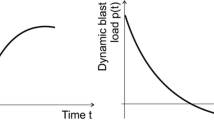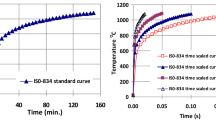Abstract
This study reveals the protective efficacy of a personal protective boot against mine blasts both experimentally and numerically. By employing analyses conducted with the use of different amounts of explosives, the protective efficacy of the developed boot is compared to a typical military boot as reference. Both for analysis and verification tests, a ballistic gelatin covered frangible leg model was used. Strain energy that is exerted on the leg was determined with numerical analyses and verified with data obtained from strain gauges that were placed on the leg model. By employing the dynamic finite elements method, the physical injury that occurred to the leg model was examined and compared with the results of the blast test. The type-2 boot decreased the strain energy by approximately 80% compared with the type-1 boot. This observation was also verified with measurements obtained from strain gauge sensors placed along the tibia bone. It was observed that the damage occurring on the tibia bone was limited to local injuries and concentrated at a single spot without causing any fractures with the type-2 boot. As a result of axial load, the leg with the type-1 boot demonstrated fractures at several points rather than a fracture at a single point based on deflection. Hence, the latter case yields irremediable injuries.
Access this chapter
Tax calculation will be finalised at checkout
Purchases are for personal use only
Similar content being viewed by others
References
Shariful, I., Makris, A., Bergeron, D.: The Spider Boot: an effective foot protective systems against anti-personnel mine blasts. J. Conventional Weapons Destruction 4(2), 1–7 (2000)
Makris, A., L’Abbe, R.J., Voisine P., et al.: Anti-personnel mine foot protection systems. US patent no: 6.006.646 (1999)
Krohn, H.F., Flynn, R.M., Sasaman, W.O.: Protective footpad assembly. US patent no. 2.720.714, 15 August 1952
Chavet, I., Madmoni, A.: Minefield shoe and method for manufacture thereof, US2003/0172554 A1, 18 September 2003
Ringler, S., Chavet, I.: Device for reducing the danger of accidental detonation of a landmine, US patent no: 4.611.411, 16 September 1986
Jordan, R.D.: Protective footgear, US patent no. 3.516.181, 23 June 1970
Fujinaka, E.S., et al.: Blast protective footwear, US patent no: 3.318.024, 31 May 1996
Vaz, G.A.: Protective boot and sole structure, US 2002/011011 A1, 31 January 2002
Vaz, G.A.: Blast and fragment resistant safety boot footwear, US patent no: 5.979.081, 9 November 1999
Joynt, V.P., Dyk, J.T.V.: Protective footwear, US 2006/0000117 A1, 5 January 2006
Zeman, P.: Anti land mine-boots, WO 03/037125 A1, 29 October 2001
Lohrmann, H.R.: Anti-personnel mine protective footpad, US patent no: 5.992.056, 30 November 1999
Peche, J.P., Gaultier, R., Peltzer, M.O.: Appliance for protecting against the effects of explosive devices, US patent no: 6.655.051, 2 December 2003
Kamberoglu, M., Karahan, M., Alpdogan, C., Karahan, N.: Evaluation of foot protection against AP mine blast: effect of deflector geometry. J. Test. Eval. (2016). doi:10.1520/JTE20150171
Trimble, K., Clasper, J.: Anti-personnel mine injury mechanism and medical management. J. Royal Army Med. Corps 147, 73–79 (2001)
Hanssen, A.G., Enstock, L., Langseth, M.: Close-range blast loading of aluminum foam panels. Int. J. Impact Eng. 27, 593–618 (2002)
Krstic, A.R.: Australian Patent No: AUPQ8943 entitled ‘A Surrogate’, July 2000
Bergeron, D.M., Coley, G.G., Fall, R.W., Anderson, I.B.: Assessment of Lower Leg Injury from Land Mine Blast – Phase 1: Test Results Using a Frangible Surrogate Leg with Assorted Protective Footwear and Comparison with Cadaver Test Data. DRDC Suffield TR 2006-051. Defence R&D, Suffield, Canada (2006)
Karahan, M., Karahan, E.A.: Development of an innovative sandwich composite material for protection of lower limb against landmine explosion: mechanical leg test results. Textile Res. J. (2016). doi:10.1177/0040517515624880
Karahan, M., Karahan, N.: Development of an innovative sandwich composite material for protection of lower limb against landmine explosion. J. Reinf. Plast. Compos. (2016). doi:10.1177/0731684416668261
Shaker, K., Jabbar, A., Karahan, M., Karahan, N., Nawab, Y.: Study of dynamic compressive behaviour of aramid and ultrahigh molecular weight polyethylene composites using Split Hopkinson Pressure Bar. J. Compos. Mater. (2016). doi:10.1177/0021998316635241
Karahan, M., Jabbar, A., Karahan, N.: Ballistic impact behavior of the aramid and ultra-high molecular weight polyethylene composites. J. Reinf. Plast. Compos. 34(1), 37–48 (2015)
Karahan, M., Yıldırım, K.: Low velocity impact properties of aramid and UHMWPE composites. Fibres Textiles Eastern Eur. 23, 3(111), 97−105 (2015)
Bergeron, D.M., Coley, G.G., Fall, R.W., Anderson, I.B.: Assessment of Lower Leg Injury from Land Mine Blast – Phase 2: Follow up Tests with a Modified Frangible Surrogate Lower Leg and Comparison with Cadaver Test Data. DRDC Suffield TR 2007-045. Defence R&D, Suffield Canada (2007)
Author information
Authors and Affiliations
Corresponding author
Editor information
Editors and Affiliations
Rights and permissions
Copyright information
© 2018 Springer International Publishing AG
About this paper
Cite this paper
Karahan, M., Karahan, N. (2018). Blast Performance of Demining Footwear: Numerical and Experimental Trials on Frangible Leg Model and Injury Modeling. In: Ahram, T. (eds) Advances in Human Factors in Sports, Injury Prevention and Outdoor Recreation. AHFE 2017. Advances in Intelligent Systems and Computing, vol 603. Springer, Cham. https://doi.org/10.1007/978-3-319-60822-8_6
Download citation
DOI: https://doi.org/10.1007/978-3-319-60822-8_6
Published:
Publisher Name: Springer, Cham
Print ISBN: 978-3-319-60821-1
Online ISBN: 978-3-319-60822-8
eBook Packages: EngineeringEngineering (R0)




